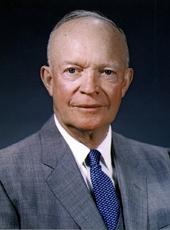
Statement by the President on the Drought and the Federal Disaster Relief Programs.
OF THE MANY natural forces that wage war on farmers and ranchers, the most demoralizing is prolonged drought. In its grip the individual farmer is well nigh helpless. Possibly my feeling about such a calamity is intensified by a family incident of many years ago. My father, a small town central Kansas merchant, went broke when drought and pests destroyed the crops in that area.
This year more than 500 counties in 14 states have been designated drought disaster areas. Last year there were 326 counties in 14 states--the year before, 1055 counties in 19 states--in 1953, 795 counties in 18 states. I cite these facts to show the broad scope of the problem.
Federal help has been correspondingly broad. During the past three years the Department of Agriculture has spent some $550,000,000 for disaster relief and about $184,000,000 to bolster livestock prices. In these three years Federal help has consisted of:
1. More than $100,000,000 worth of Government-owned surplus foods distributed free through state welfare offices to needy people in cities, towns and rural areas.
2. More than $140,000,000 worth of Government-owned surplus feed grains to help farm and ranch families maintain foundation livestock.
3. Free grain furnished to small farm families through state welfare offices to maintain subsistence livestock.
4. More than $26,000,000 to help buy hay and other roughage to maintain foundation livestock, including dairy cattle.
5. More than $18,000,000 to help carry out wind erosion control measures.
6. Special permission in 562 counties in 12 states to graze soil bank reserved acres.
7. Nearly $260,000,000 for emergency credit and livestock loans.
8. More than $184,000,000 for beef and pork products to strengthen distressed livestock prices. Frozen hamburger is now being purchased to help stabilize prices of certain grades of cattle.
9. More than $1,000,000 of long-term, favorable-rate loans for small businesses in drought-stricken communities.
Despite these efforts, the drought this year has reached disastrous proportions for ranchers and farmers in some areas--especially in the Southwest. Drought has persisted there for years. Again this year Fall rains have not come.
We will continue to use freely every existing program and legal authority to ease the plight of these hard-hit families. In addition, these steps are now being taken to help relieve the distress:
1. To help maintain foundation livestock herds, we are increasing from $1.00 to $1.50 per hundred pounds the Federal subsidy paid with Government-owned feed grains. This will cut feed costs and move more grain from government stocks to droughtstricken farmers and ranchers. Secretary of Agriculture Benson will issue the details promptly.
2. Yesterday the Board of Directors of the Export-Import Bank of Washington authorized a loan of $5,000,000 to Mexico to buy United States beef and dairy cattle. Of this, at least $3,750,000 is expected to buy some 40,000 beef cattle from livestock owners in the southwest who are short of feed. Purchasing agents of other foreign governments are visiting the southwestern states this week in connection with pending negotiations to buy beef for foreign consumption.
3. We have already used up the $10,500,000 available to buy hay and other roughage to maintain foundation livestock during this fiscal year. One-half of it is committed in Texas. I have allocated $5,000,000 more from Federal Civil Defense disaster relief funds and will allocate such additional sums as may be needed to continue this program until the Congress convenes and supplemental funds can be appropriated.
4. Another heavy drain on distressed farmers and ranchers is the payment of full transportation charges on hay needed for the next few months. It may also be necessary to send substantial numbers of livestock from dry pastures to other areas for temporary feeding. Yesterday we asked the western railroads to consider ways and means of assisting farm and ranch people in drought areas during this difficult period.
The present disaster relief programs are the most extensive ever applied. I most earnestly hope that those programs and the new steps mentioned will help ease the present distress.
Before the end of the year I plan to visit the stricken areas to make certain that the present programs are giving maximum help and that the additional steps mentioned are having good results. While there I will meet with Federal, state and local officials administering the drought relief programs, and also with affected farmers and ranchers, to develop any needed additional programs, including new legislation, for submission to the next Congress.
Dwight D. Eisenhower, Statement by the President on the Drought and the Federal Disaster Relief Programs. Online by Gerhard Peters and John T. Woolley, The American Presidency Project https://www.presidency.ucsb.edu/node/233365
